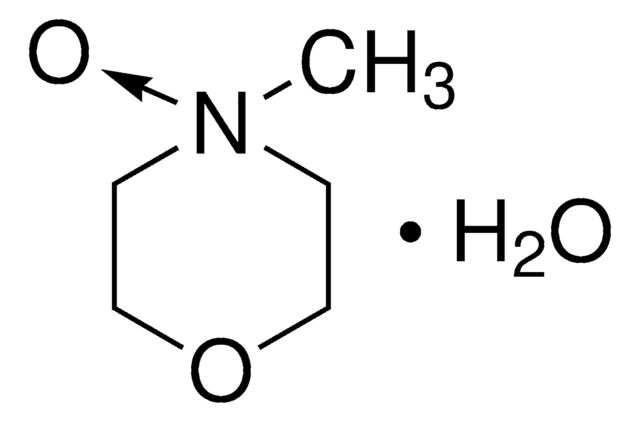330744
Tetrapropylammonium perruthenate
97%
Sinónimos:
TPAP
Seleccione un Tamaño
Seleccione un Tamaño
About This Item
Productos recomendados
Ensayo
97%
Formulario
solid
idoneidad de la reacción
reagent type: oxidant
mp
~160 °C (dec.) (lit.)
grupo funcional
amine
cadena SMILES
[O-][Ru](=O)(=O)=O.CCC[N+](CCC)(CCC)CCC
InChI
1S/C12H28N.4O.Ru/c1-5-9-13(10-6-2,11-7-3)12-8-4;;;;;/h5-12H2,1-4H3;;;;;/q+1;;;;-1;
Clave InChI
NQSIKKSFBQCBSI-UHFFFAOYSA-N
¿Está buscando productos similares? Visita Guía de comparación de productos
Categorías relacionadas
Descripción general
Aplicación
- For the conversion of sulfides to sulfones by oxidation reaction.[2]
- In the isomerization of allylic alcohols into the corresponding saturated carbonyl derivatives.[3]
- Along with N-methylmorpholine N-oxide (NMO) for the cleavage of glycol to carboxylic acids.[4]
TPAP can also be used as an oxidizing reagent:
- For the oxidation of benzyl alcohol to benzaldehyde and steroidal alcohols to corresponding ketones.[5][6]
- To convert N,N′-dihydroxyimidazolidines to nitronyl nitroxide free radicals.[7]
- To oxidize hydroxyl-substituted tri-n-butylammonium trifluoroborates to aldehydes and ketones without concomitant cleavage of the carbon-boron bond.[8][9]
Código de clase de almacenamiento
11 - Combustible Solids
Clase de riesgo para el agua (WGK)
WGK 3
Punto de inflamabilidad (°F)
Not applicable
Punto de inflamabilidad (°C)
Not applicable
Equipo de protección personal
Eyeshields, Gloves, type P3 (EN 143) respirator cartridges
Elija entre una de las versiones más recientes:
¿Ya tiene este producto?
Encuentre la documentación para los productos que ha comprado recientemente en la Biblioteca de documentos.
Los clientes también vieron
Artículos
Oxidation and reduction reactions are some of the most common transformations encountered in organic synthesis
Active Filters
Nuestro equipo de científicos tiene experiencia en todas las áreas de investigación: Ciencias de la vida, Ciencia de los materiales, Síntesis química, Cromatografía, Analítica y muchas otras.
Póngase en contacto con el Servicio técnico











